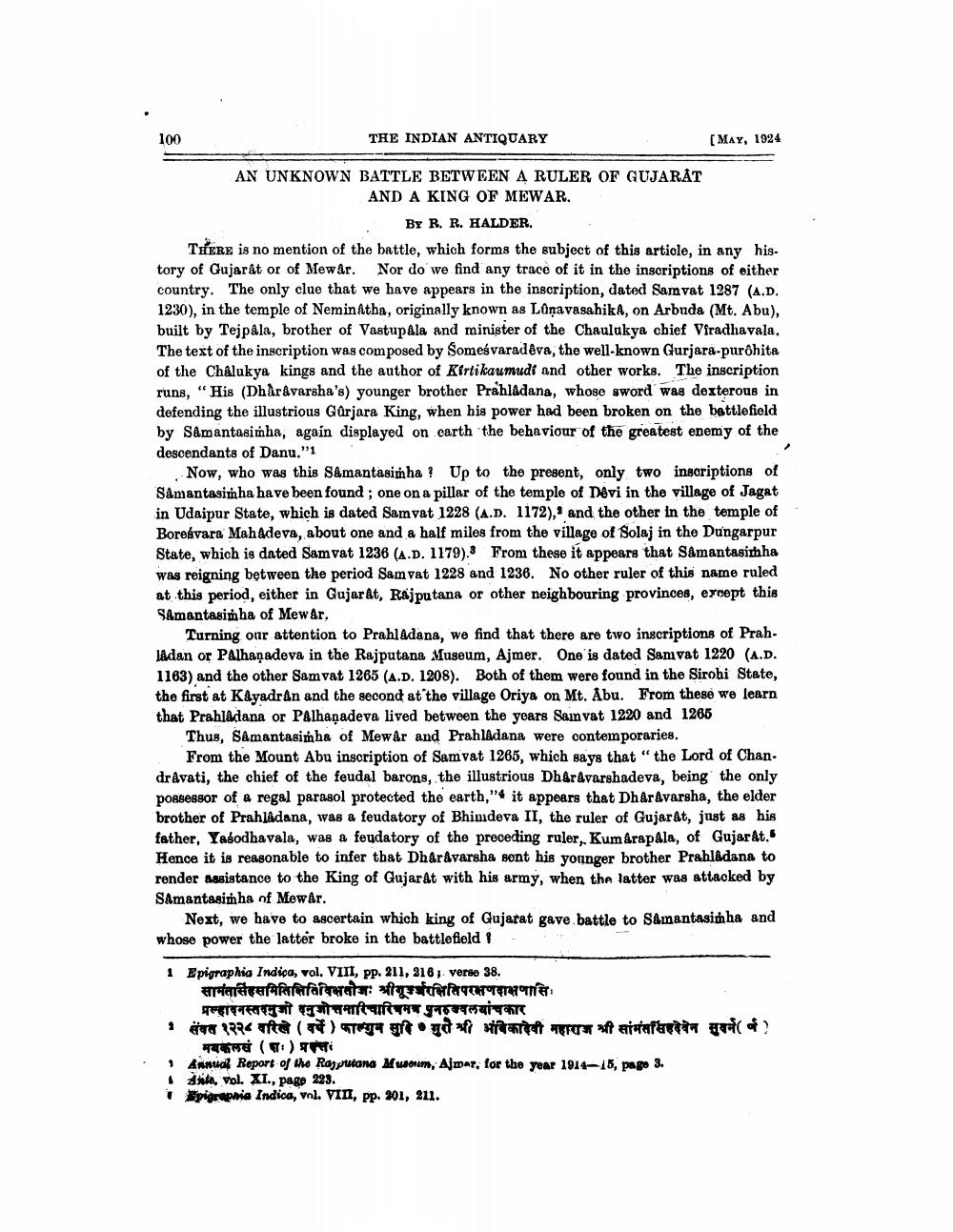________________
THE INDIAN ANTIQUARY
AN UNKNOWN BATTLE BETWEEN A RULER OF GUJARAT AND A KING OF MEWAR.
By R. R. HALDER.
THERE is no mention of the battle, which forms the subject of this article, in any history of Gujarat or of Mewår. Nor do we find any trace of it in the inscriptions of either country. The only clue that we have appears in the inscription, dated Samvat 1287 (A.D. 1230), in the temple of Neminatha, originally known as Lunavasahika, on Arbuda (Mt. Abu), built by Tejpala, brother of Vastupala and minister of the Chaulukya chief Viradhavala. The text of the inscription was composed by Somesvaradeva, the well-known Gurjara-purôhita of the Chalukya kings and the author of Kirtikaumudi and other works. The inscription runs, "His (Dharâvarsha's) younger brother Prahladana, whose sword was dexterous in defending the illustrious Gurjara King, when his power had been broken on the battlefield by Samantasimha, again displayed on earth the behaviour of the greatest enemy of the descendants of Danu."1
100
[MAY, 1924
Now, who was this Samantasimha? Up to the present, only two inscriptions of Samantasimha have been found; one on a pillar of the temple of Devi in the village of Jagat in Udaipur State, which is dated Samvat 1228 (A.D. 1172), and the other in the temple of Boresvara Mahadeva, about one and a half miles from the village of Solaj in the Dungarpur State, which is dated Samvat 1236 (A.D. 1179). From these it appears that Samantasimha was reigning between the period Samvat 1228 and 1236. No other ruler of this name ruled at this period, either in Gujarat, Rajputana or other neighbouring provinces, except this Samantasimha of Mewår,
Turning our attention to Prahladana, we find that there are two inscriptions of Prahlådan or Palhaṇadeva in the Rajputana Museum, Ajmer. One is dated Samvat 1220 (A.D. 1163) and the other Samvat 1265 (A.D. 1208). Both of them were found in the Sirohi State, the first at Kayadrân and the second at the village Oriya on Mt. Abu. From these we learn that Prahladana or Palhaṇadeva lived between the years Samvat 1220 and 1265
Thus, Samantasimha of Mewâr and Prahladana were contemporaries.
From the Mount Abu inscription of Samvat 1265, which says that "the Lord of Chandravati, the chief of the feudal barons, the illustrious Dhârâvarshadeva, being the only possessor of a regal parasol protected the earth," it appears that Dhârâvarsha, the elder brother of Prahladana, was a feudatory of Bhimdeva II, the ruler of Gujarat, just as his father, Yasodhavala, was a feudatory of the preceding ruler, Kumarapala, of Gujarat. Hence it is reasonable to infer that Dhârâvarsha sent his younger brother Prahladana to render assistance to the King of Gujarat with his army, when the latter was attacked by Samantasimha of Mewår.
Next, we have to ascertain which king of Gujarat gave battle to Samantasimha and whose power the latter broke in the battlefield
1 Epigraphia Indica, vol. VIII, pp. 211, 216; verse 38. entreffefaivedte: silquakeforfavorwerfer,
averweeg egenwatcafeenw gay LEGGİZEM
1 संवत १२२८ वरिखे ( वर्षे) फाल्गुन सुदि • गुरो श्री अंबिकादेवी महाराज श्री सांगतसिंहदेवेन सुवर्न ( )
नवकल (शः) प्रत
1 Annual Report of the Rajputana Museum, Ajmer, for the year 1914-15, page 3.
Ante, vol. XI., page 223.
Epigraphia Indica, vol. VIII, pp. 201, 211.




